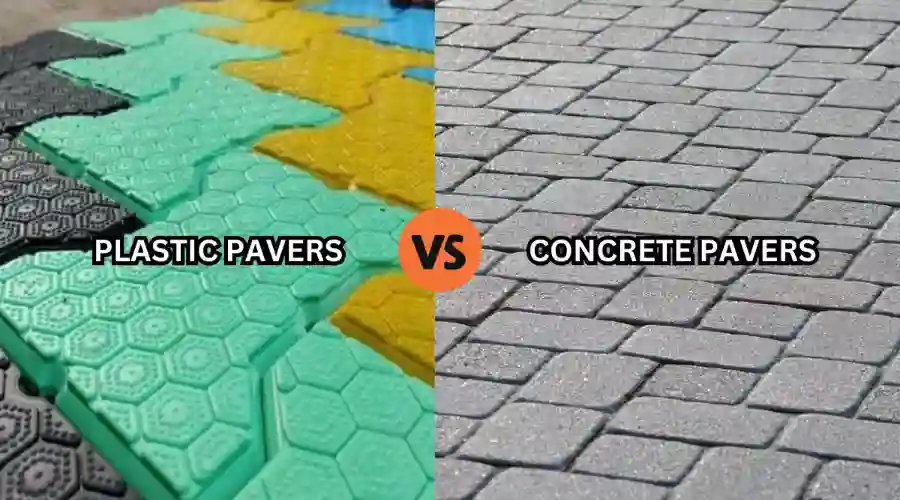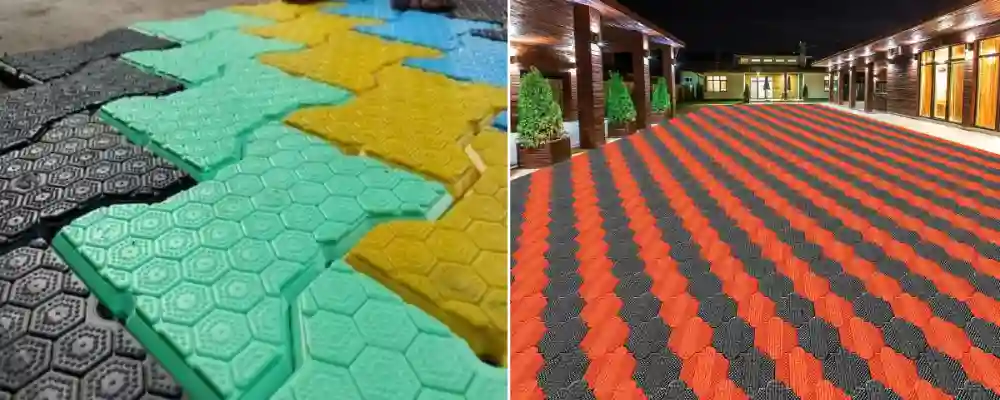In today’s environmentally conscious world, managing plastic garbage is a major challenge. Waste plastic may be creatively transformed into useful building materials with plastic paver blocks. These durable, versatile paving choices help solve the global plastic crisis and provide a desirable alternative to traditional concrete pavers. This Brick & Bolt article explores the ways that plastic pavers are changing outdoor surfaces and advancing sustainability over time.
What Are Plastic Paver Blocks?
Plastic paver blocks are modular paving units made mainly from repurposed plastic materials. With one exception, they are comparable to traditional clay or concrete pavers. High-density polyethylene (HDPE), polyethylene terephthalate (PET), and other recycled polymers are typically used to make them. A significant portion of plastic that would otherwise end up in landfills or the ocean may be found in plastic pavers.
Plastic pavers are lighter and more flexible. They also have advanced interlocking mechanisms that do not require mortar or adhesives when installed, in contrast to traditional pavers. They are naturally resistant to water, chemicals, and various types of deterioration that affect concrete substitutes due to their composition.
Benefits of Plastic Paver Blocks
Eco-Friendly and Sustainable
Plastic pavers turn waste into something useful, upcycling 5-10kg of plastic per square metre. While producing plastic pavers it consumes less energy and emits less carbon. Permeable options mean rainwater can penetrate, helping to recharge groundwater and avoid flooding. By encapsulating circular economy values, the pavers present environmental advantages to environmentally aware property owners.
Easy Installation and Maintenance
Plastic pavers offer unmatched handling convenience because they are 60–70% lighter than their concrete counterparts. Their interlock design allows DIY-friendly, mortar-free installation much quicker than traditional techniques. The maintenance requirements are low—no sealing, easy washing for cleaning, and unit replacement ease. Their minimal flexibility allows for tolerating minor ground movements without cracking, providing long-term stability.
Cost-Effective Solution
Most plastic paver types equal mid-range concrete products in cost while providing savings through less labour required. Their long life reduces overall replacement costs over the product life cycle. Permeable types can obviate the requirement for individual drainage systems in most uses. Some authorities offer tax credits for utilizing recycled materials as an added financial enticement.
Durability and Longevity
Durable plastic pavers withstand freeze-thaw deterioration, UV degradation, and chemical exposure that weaken concrete. Their through-body colouration avoids surface wear concerns associated with conventional pavers. Innovative designs can bear vehicle loads similar to concrete but are light in weight. Frequently supported by 20+ year warranties, plastic pavers retain their performance with minimal maintenance.
Applications of Plastic Paver Blocks
The flexibility of plastic pavers renders them applicable for many uses:
- Plastic paver blocks exhibit high versatility in many environments.
- In residential settings, they create stunning driveways, patios, garden paths, and pool surrounds that are both aesthetically pleasing and useful.
- Commercial establishments enjoy their application in parking lots, outdoor restaurants, and walkways where drainage and minimal maintenance are desired.
- Public areas such as parks, playgrounds, and beach access roads take advantage of their strength and safety features.
- These pavers also perform exceptionally well in specialized uses, such as erosion control on slopes, green roof systems, equestrian arenas, and temporary event surfaces.
- Their versatility in various environments and loading conditions continues to increase their application in sustainable construction projects globally.
Manufacturing Process of Plastic Paver Block
Collection and Preparation
The recycling of plastic waste to form hardy paver blocks incorporates a high-tech process integrating recycling technology with high-precision manufacturing. It starts with the gathering and sorting of plastic waste according to the polymer it belongs to to guarantee the compatibility of the material. The sorted plastic is cleaned to remove impurities before being shredded into uniform, small flakes.
Molding and Formation
These flakes are subsequently melted at controlled temperatures (usually 200-250°C) and usually mixed with performance-improving additives like UV stabilizers, colour pigments, and structural aids like fiber or mineral content. The molten composition is then poured into specially shaped molds under pressure, employing either the injection or compression molding process to impart the desired paver form and interlocking configurations.
Quality Control and Distribution
Once molded, the pavers are cooled in a controlled environment to avoid warping or the formation of internal stress. Every batch is thoroughly tested for compression strength, water absorption, abrasion resistance, and dimensional accuracy before approval for distribution. This process of manufacturing requires much less energy than concrete manufacture and produces essentially no waste since rejected pieces can be easily remelted and reprocessed.
Installation Process of Plastic Paver Blocks
Installation of plastic paver blocks is accomplished by following these general steps, although manufacturer requirements may differ:
Site Preparation
Plastic paver block installation is a simple procedure that can be performed by most reasonably skilled homeowners with fundamental tools. Proper site preparation is the starting point for the installation, such as removing vegetation and digging to the depth recommended for the proposed application, generally 15-25 cm based on the purpose of use. A geotextile mat is placed over the ground to avoid weed growth and isolate the base aggregate from the subsoil.
Base Construction and Edge Restraints
Secondly comes the vital support. A layer of 10-15 cm of compactable gravel or broken stone that’s properly compacted with a plate compactor. Thin, even bedding with 2-5 cm coarse sand is levelled carefully using straight edges or screeds. Install edge supports around the borders before placing the pavers.
Paver Placement and Finishing
The pavers are set as per the intended design pattern, interlocking their locking mechanisms. To make cutouts for use around obstacles or borders, the pavers may be trimmed using a handsaw or jigsaw. With their intended use, grid pavers are filled with gravel, sand, or soil. The pavers are set firmly with light compaction before they are finally cleaned and plantings, as desired, are installed. The entire process typically requires 30-50% less time than installing traditional concrete pavers.
Plastic vs Concrete Paver Blocks

When comparing plastic and concrete paver options, consider these key differences:
| S.no | Feature | Plastic Pavers | Concrete Pavers |
| 1 | Weight | Very light, easy to lift and move | Heavy and hard to carry |
| 2 | Installation | Simple to install, can be done by yourself | Takes more effort and may need expert help |
| 3 | Environment Impact | Made from recycled plastic, eco-friendly | Produces more pollution during production |
| 4 | Flexibility | Can bend a little with ground changes | Stiff and may crack if the ground moves |
| 5 | Water Drainage | Often lets water pass through | Usually blocks water unless specially made to drain |
| 6 | Toughness | Handles freezing and thawing well | Might crack in very cold weather |
Conclusion
Plastic paver blocks are an ingenious combination of green waste disposal and eco-friendly construction. On your next paving installation, turn to the sustainable solution of plastic pavers. Let Brick & Bolt’s trained staff assist you in choosing the perfect plastic paver solution for your particular project with professional installation and lasting performance. Call Brick & Bolt now and see how plastic pavers, the green option, can boost your property value while aiding the cause of a greener future.

